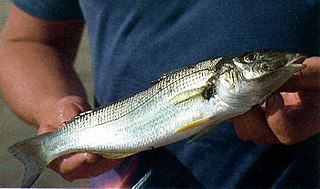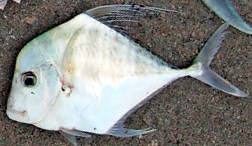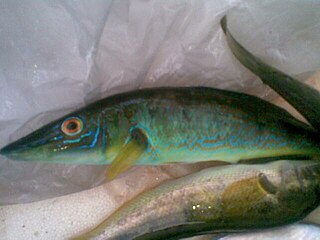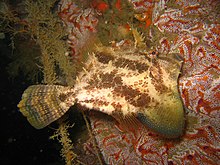
The filefish (Monacanthidae) are a diverse family of tropical to subtropical tetraodontiform marine fish, which are also known as foolfish, leatherjackets or shingles. They live in the Atlantic, Pacific and Indian Oceans. Filefish are closely related to triggerfish, pufferfish and trunkfish.

The red morwong, also known as the sea carp, is a species of marine ray finned fish traditionally regarded as belonging to the family Cheilodactylidae, the members of which are commonly known as morwongs. It is found off southeast Australia and the North Island of New Zealand from shallow depths to at least 55 m, on rocky reef and coastal areas. Its length is between 30 and 60 cm.

The Australian angelshark is a species of angelshark, family Squatinidae, found in the subtropical waters of southern Australia from Western Australia to New South Wales between latitudes 18°S and 41°S, at depths down to 255 m (840 ft). Its length is up to 1.52 m (5 ft). Reproduction is ovoviviparous, with up to 20 pups in a litter.

The demersal zone is the part of the sea or ocean consisting of the part of the water column near to the seabed and the benthos. The demersal zone is just above the benthic zone and forms a layer of the larger profundal zone.

The black goby is a species of ray-finned fish found in the Eastern Atlantic and Mediterranean Sea and Black Sea. It inhabits estuaries, lagoons, and inshore water over seagrass and algae. It feeds on a variety of invertebrates and sometimes small fish. This species can also be found in the aquarium trade.

The sand whiting, also known as the summer whiting, yellowfin whiting or blue-nose whiting, is a common species of coastal marine fish of the family Sillaginidae, the smelt-whitings. It is a slender, slightly compressed fish that is very similar to other species of Sillago, with detailed spine, ray and lateral line scale counts needed to distinguish the species between its nearest relative Sillago analis. The sand whiting is distributed along the east coast of Australia from Cape York south to Tasmania, as well as Lord Howe Island and New Caledonia in the Pacific Ocean.

The Indian threadfish, also known as the Indian threadfin, diamond trevally, mirror fish or plumed trevally, is a large species of coastal marine fish of the jack family, Carangidae. The species is widespread in the waters of the tropical Indo-West Pacific Ocean, ranging from east Africa to India, Asia, Indonesia and Australia. Adult fish tend to inhabit coastal waters over reefs down to 100 m in depth, while juveniles inhabit a variety of environments including estuaries and seagrass beds. The Indian threadfish is similar to the other two species in the genus Alectis, with a slight concavity in the profile of the head the most obvious distinguishing feature. It is a large species, growing to 165 cm and 25 kg in weight. The species is carnivorous, consuming fishes, cephalopods and crustaceans. The Indian threadfish is of minor commercial importance, and has been the subject of aquaculture in Singapore.

Cantherhines dumerilii is a species of fish in the family Monacanthidae, the filefishes. Its common names include whitespotted filefish, barred filefish, orange-fin file, and yelloweye leatherjacket. It is distributed in the Indian and Pacific Oceans where it is found on coral reefs.

Thalassia testudinum, commonly known as turtlegrass, is a species of marine seagrass. It forms meadows in shallow sandy or muddy locations in the Caribbean Sea and the Gulf of Mexico. Turtle grass and other seagrasses form meadows which are important habitats and feeding grounds. The grass is eaten by turtles and herbivorous fish, supports many epiphytes, and provides habitat for juvenile fish and many invertebrate taxa.

The seaweed blenny is a species of combtooth blenny found in coral reefs in the western Atlantic Ocean along the coasts of New York, Bermuda, the Bahamas, also in the Gulf of Mexico, south to southern Brazil. This species reaches a length of 8.5 centimetres (3.3 in) TL.

Stegastes fuscus, the dusky damselfish, is a species of bony fish in the family Pomacentridae found near the seabed in shallow waters on the western fringes of the Atlantic Ocean.

Stephanolepis cirrhifer, commonly known as the thread-sail filefish, is a species of marine fish in the family Monacanthidae. It is found in the western Pacific, in an area that ranges from northern Japan to the East China Sea, to Korea. Other common names for the fish include kawahagi (カワハギ,皮剥) (Japanese) and “쥐치” "Jwi-chi" (Korean). The fish grows to a maximum length of about 12 inches, and consumes both plant material and small marine organisms like skeleton shrimp. S. cirrhifer is host of the parasite Peniculus minuticaudae. Some minor genetic differentiation between S. cirrhifer born in the wild and those bred in a hatchery for consumer use has been shown. The fish is edible and sold commercially for culinary purposes in many Asian countries.

Stephanolepis hispidus, the planehead filefish, is a species of bony fish, a ray-finned fish in the family Monacanthidae.

Bartholomea annulata is a species of sea anemone in the family Aiptasiidae, commonly known as the ringed anemone or corkscrew anemone. It is one of the most common anemones found on reefs in the Caribbean Sea.

Monacanthus is a genus of filefishes.

Cantherhines pardalis is a species of fish in the family Monacanthidae, the filefishes. Common names include honeycomb filefish, honeycomb leatherjacket, and wire-netting filefish. It is native to the Indian Ocean, the eastern Atlantic, and the western Pacific, except for the seas around Hawaii, where it is replaced by Cantherhines sandwichiensis.

The blue weed whiting is a species of ray-finned fish, a weed whiting from the family Odacidae, which is endemic to Australia where it is only found along the southern coast. It is found in brackish and marine waters in sheltered locations at depths of from 1 to 7 metres. This species inhabits areas with a substrate of sand with beds of seagrass where it feeds on small invertebrates and algae and the seagrasses themselves. This species grows to a length of 29 centimetres (11 in) SL. It is of minor importance to local commercial fisheries. This species is the only known member of its genus.

Monacanthus ciliatus, commonly known as the fringed filefish, the cuckold or the leather-fish, is a species of bony fish commonly found in shallow water in the western Atlantic Ocean, the Caribbean Sea and the Gulf of Mexico.

Stephanolepis diaspros, commonly known as the reticulated filefish or the reticulated leatherjacket, is a species of bony fish, a ray-finned fish in the family Monacanthidae. Its natural range is the western Indian Ocean but it is also one of the species which has colonised the Mediterranean through the Suez Canal by Lessepsian migration from the Red Sea.
Maroubra perserrata, also known as the sawtooth pipefish is a species of marine fish belonging to the family Syngnathidae. This species can be found at depths up to 20 meters along the coast of Australia from southern Queensland to southern Western Australia. While they can live in many different habitats, they are often found inhabiting openings in reefs and rocks that contain algae and invertebrates, which they likely rely on for camouflage. Reproduction occurs through ovoviviparity in which the males brood eggs for roughly 22 days before giving live birth. Maroubra perserrata is considered more mobile than many pipefish species due to its prehensile tail and reduced caudal fin.



















